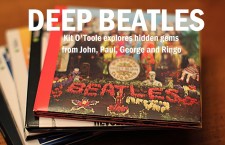One of the early tracks recorded for the planned Get Back project, “Teddy Boy” failed to make the final Let It Be track listing. However, it does showcase Paul McCartney’s gift for writing a simple melody, something he would further demonstrate on his debut solo album and subsequent Wings discs.
The origins of “Teddy Boy” date back to the Beatles’ 1968 Rishikesh retreat, and the lyrics describe a mother and son consoling each other over the loss of the boy’s soldier father. The title phrase derives from an English term: In the mid-1950s, rebellious teen boys assumed a style described as a cross between American rock ’n roll and Edwardian Dandy. Drainpipe trousers, skinny ties, velvet blazers, and a pompadour-type hairstyle completed the look, distinguishing these “bad boys” from other teenagers. Perhaps McCartney intended to portray the main character as “tough but tender,” or simply wanted to reminisce about his youth.
Paul McCartney brought “Teddy Boy” to the Beatles during the Twickenham sessions. They began on the track until January 24, when they recorded six versions. A six-minute take was mixed by Glyn Johns for the planned Get Back album, but did not see the light of day until the Anthology 3 compilation. This version, however, combined elements of the six-minute take and parts of an additional attempt on January 28. (The Beatles completed two takes during that session.) A final rehearsal took place on January 29, but the group never worked on the song again.
When Let It Be director Michael Lindsay-Hogg suggested filming the Beatles performing “Teddy Boy,” McCartney rejected the idea. Phil Spector ultimately produced the Get Back tapes, and he remixed the track for the soundtrack album, but once again “Teddy Boy” was left the final project.
Judging from the existing recordings, the Beatles were not particularly enthusiastic about “Teddy Boy.” On Anthology 3, Lennon talks in the background, employs funny voices, and even imitates a square-dance caller. Despite the lack of interest, McCartney soldiers on, softly crooning the lyrics (exploding into a laugh at one point) while strumming his acoustic guitar. George Harrison experiments with lead guitar parts while Ringo Starr executes subtle drumming, clearly aware they were still feeling their way through the track.
Lyrically, the song is simple but undeniably catchy, particularly the chorus: “Mommy don’t worry, now Teddy Boy’s here / Taking good care of you. … Teddy’s gonna see you through.” The narrative first focuses on the son comforting his mother; presumably her husband (his father) had been killed.
The plot thickens when the mother embarks on a new relationship; in response, Teddy runs away. “He couldn’t stand to see his mother in love / With another man he didn’t know,” McCartney sings, somewhat disturbingly matter-of-factly. Evidently he does not return, as “he found a place where he could settle down” and reminisce about how he used to take care of his mother. In a twist ending, the mother’s voice enters the scene: “Teddy don’t worry, now Mommy is here / Taking good care of you.” Does this change in perspective hint at some kind of reconciliation?
When working on material for his self-titled 1970 debut album, McCartney returned to “Teddy Boy,” recording the basic track at his home studio in December 1968 or January 1970. In early February, he complied overdubs at Willesden’s Morgan Studios.
During a 2004 interview with Music Radar, McCartney commented on why many of his early solo songs learned toward an acoustic sound. “When I worked with the Beatles, there were at least two guitars, and when I played there were three. We would often play a song through on acoustic, and sometimes we’d develop it from there on electric — or sometimes we just kind of liked it where it was, and it stayed acoustic,” McCartney said. “On those early solo albums, I didn’t have the guys I developed things up with — John and George — and so things often remained acoustic. Of course, I also liked how it sounded [laughs].”
“Teddy Boy” may not rank as one of McCartney’s best-known tracks, but it does preview his successful solo career with its lilting melody and pared-down production. McCartney, Ram, Wild Life, and Band on the Run also contained elements of this sound. In other words, the beauty of “Bluebird” may not have been possible without “Teddy Boy.”
- How John Lennon Came Roaring Back on the Beatles’ White Album - November 22, 2023
- Five ‘With the Beatles’ Deep Cuts That Illustrate Their Lasting Debt to R&B - November 20, 2023
- Five Must-Hear Deep Cuts from the Beatles’ ‘Past Masters’ - March 7, 2023


